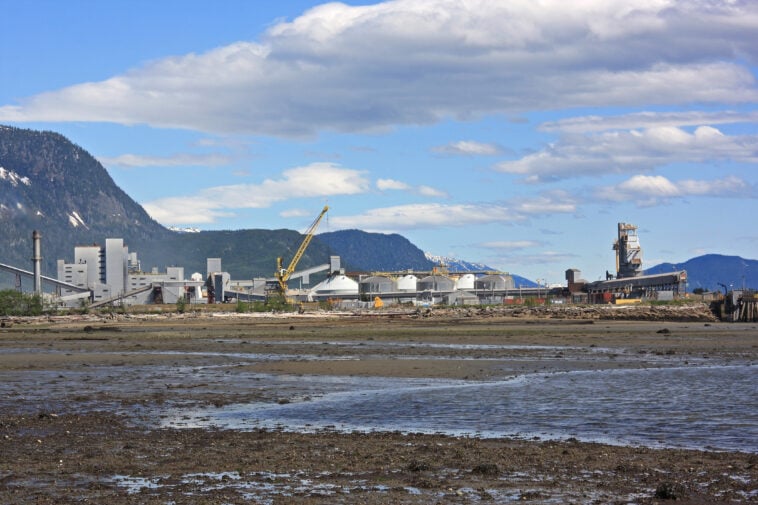In Kitimat, the air sometimes has a taste. It’s a sharp, metallic tang that hangs in the throat, a constant reminder of the industrial pillars that help shape this community.
The plumes from the Rio Tinto aluminum smelter don’t just signal economic activity; they carry up to 42 tonnes of sulphur dioxide (SO₂) into the sky every day, an amount that provincial regulators officially sanctioned over a decade ago.
This gas is more than an odour; it’s a known health concern. When inhaled, SO₂ reacts quickly with moisture in the lungs to form sulfuric acid, damaging delicate tissues and making breathing difficult. It’s a particular trigger for asthma attacks, especially in the most vulnerable: children and the elderly.
“We didn’t have much time to respond to this decision as a community.”
Pam Vollrath, Living Here Magazine
This reality was not entirely unforeseen. As longtime resident Pam Vollrath recalled in Living Here magazine, the community was surprised to learn that the company had originally planned to install sulphur dioxide scrubbers (pollution control devices for smokestacks) as part of the smelter’s modernization, but later removed them from the project.
“We didn’t have much time to respond to this decision as a community,” Vollrath said. That decision, made years ago, continues to shape the atmosphere of the valley today.
Alcan maintains that current emissions are regularly monitored, and that its “BC Works” operations conduct continuous ambient air quality and meteorological monitoring at five stations in the lower Kitimat valley and one specialized station at Lakelse Lake.
And yet, according to Living Here magazine, “for every 1,000 people who live in Kitimat (just over 8,000 people live there), 12.4 have asthma and 21.4 have chronic obstructive pulmonary disease (COPD). The former is 104% higher than the provincial average, the latter 183% higher.”
The conversation in Kitimat is increasingly shifting from individual incidents to the collective weight of industrial activity. On social media, residents describe the pervasive nature of the issue. On Skeena Strong Facebook, Nicholas Luiken noted that, “You sleep in CVL with your window open (before the flare) and get a cough/sore throat: The Kitimat cough…”

Accounts point to a community under sustained pressure. Both the Rio Tinto smelter and the growing presence of LNG Canada have become focal points in this debate. The challenge is not to weigh one project against another, but to manage the cumulative burden of multiple sources on Kitimat’s air and water recognizing that they combine into a single, heavier load for the community to bear.
This concept of cumulative impact is formally recognized in federal environmental assessments. For example, Fisheries and Oceans (DFO)’s research document on the Skeena River watershed notes that they explicitly require that decision-makers consider the combined effects of multiple developments on fish and fish habitat.
For a town like Kitimat, where the economy and culture are deeply tied to the marine environment, this is a critical concern. The same waters that host industrial activity are the lifeblood for wild salmon, a cornerstone of the coastal food web. The federal document’s conclusion frames a fundamental challenge: as industrial footprints expand, the potential for these cumulative effects – on air, water, and the species that depend on them – grows exponentially.
“The community is hoping the Environmental Appeals Board will require Rio Tinto Alcan to control SO2 emissions using conventional scrubbing technology, preserving the region’s vulnerable lakes and allowing residents of Kitimat to breathe cleaner air.”
Dr. Mark Chernaik. Science Program Director, ELAW
Kitimat finds itself at a complex crossroads, navigating the benefits of industrial investment against the tangible costs to the health of its residents and its coastal economy.
The trade-offs are measured in the sharpness of the air on a still day.
Experts have repeatedly spoken out on Kitimat’s air quality since 2015. When a permit to dramatically increase the release of sulphur dioxide (SO2) emissions in the Kitimat air-shed was applied for, Dr. Brian Scarfe, an Economist at the University of Victoria, testified at the BC Environmental Appeal Board hearings that the externalized health costs placed on residents living near the Kitimat smelter would outstrip the cost of introducing scrubbers; which remove SO2 pollution from effluent; to the RTA plant.
And yet, scrubbers were never installed even after a residents’ group represented by ELAW appealed to the Environmental Appeals Board. ELAW scientist Mark Chernaik, who served as an expert witness for Kitimat residents advocating for cleaner air, said: “The community is hoping the Environmental Appeals Board will require Rio Tinto Alcan to control SO2 emissions using conventional scrubbing technology, preserving the region’s vulnerable lakes and allowing residents of Kitimat to breathe cleaner air.”

As the possibility of more projects coming to Kitimat looks increasingly likely, community members aren’t just thinking of the prosperity it will bring to the present. Some, like Ginny Charron, who commented on Skeena Strong’s Facebook, are concerned about the future: “The billowing black smoke needs to be resolved. It cannot be healthy for the younger members of the community who may breathe this in for decades.”
The questions now being asked of the old and the new industrial projects in community forums/social media are evolving. They are about the systems designed to protect the public, air, and water. Are the monitoring regimes sufficient to track the combined outputs? Are the pollution control technologies across all facilities the best available? And as the industrial base grows, who is responsible for monitoring the total load on the environment that sustains the community?
The story of Kitimat is becoming a case study for modern Canada: a test of how a community can thrive economically without being overwhelmed by the environmental footprint of its economy.
The answers will determine not just the taste of the air, but the long-term health of the valley and its people.




